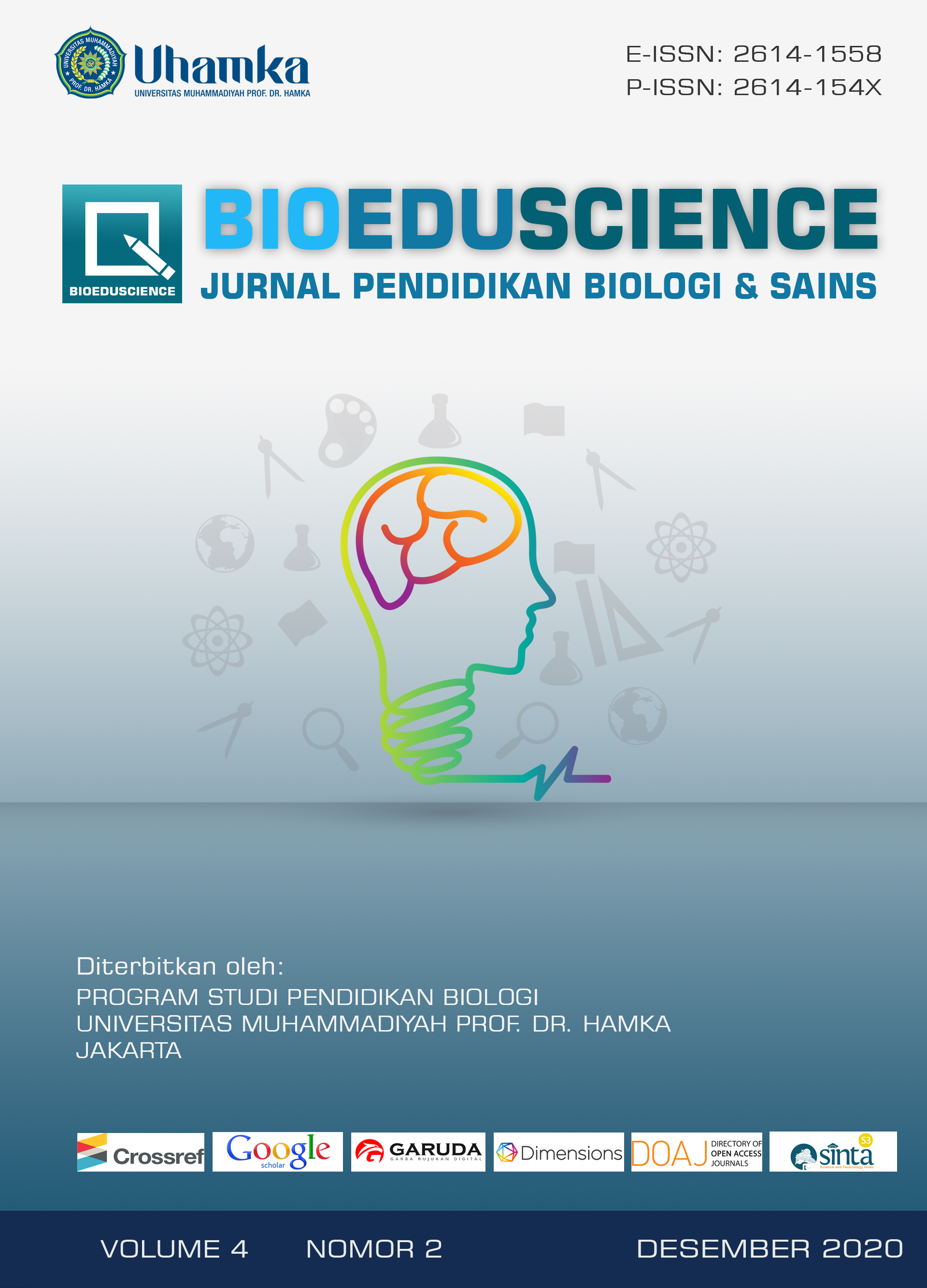Analysis of Language Literacy Skills in Biological Learning Contexts
Abstract
Background: The results of PISA showed that Indonesian students' literacy skills in the field of science are still low. Until now, the cause of the problem is still little information reported. This study was conducted to analyze the language literacy skills of students in biological learning contexts. Methods: the methods used in the research is mixed methods research. This research involved 72 science program students who were selected by purposive sampling. The data were gained by observations, interviews and giving the posttest consisting of 17 questions of multiple-choice based on the Programme for International Student Assessment (PISA) indicator for language literacy in biological learning. Results: That the analysis of language literacy in the context of Biological learning has an excellent literacy with a high category. The research showed that the highest average grade of language literacy was in the integrate and interpret aspects of 75,00. Meanwhile, the lowest average grade in the reflect and evaluate aspects was 57,00. The average overall grade in the language literacy on Biological learning was 70,22. Conclusion: Sustainable literacy activities stimulate higher-order thinking skills, especially in the field of science, because language literacy skills can indirectly affect students' outcomes on scientific skills.
Full text article
References
Aisyah, S. N. (2014). Peranan PhET ABS Dalam Pembelajaran Remedial Terhadap Penguasaan Konsep Larutan Asam Basa dan Membangun Keterampilan Berpikir Kritis Siswa SMA. Thesis.
Benson, V. (2002). Shifting paradign and pedagogy with nonfition: A call to arms for survival in the 21 st century. The New England Reading Association Journal, 38, 1–6.
Chafe, W. (1994). Discourse, consciusness, and time. The University of Chicago Press.
Cladwell, J. S. (2008). Comprehension assessment: A classroom guide. The Guilford Press.
Donald, M. (1991). Origins of the modern mind: three stages in the evolution of culture and cognition. Harvard University Press.
Enih, S. (2010). Pengembangan Model Pembelajaran Inquiry Untuk Meningkatkan Kemampuan Memahami Isi Bacaan: Studi Pada Mata Pelajaran Bahasa Indonesia kelas XI di SMAN Kota Serang. Tesis.
Fadilah, Isti, S., Wida, T., Amarta, D., & Prabowo, C. A. (2020). Analisis Kemampuan Literasi Sains Siswa pada Pembelajaran Biologi Menggunakan NOSLiT. Bioeduin: Jurnal Program Studi Pendidikan Biologi, 10(1), 27–34.
Goody, J., & Watt, I. (1963). The consequences of literacy. Contemporary Studies in Society and History 5.
Grace, M. (2012). Penggunaan Metode Bercerita dalam Meningkatkan Aspek Pengembangan Anak Usia Dini. Skripsi.
Hadi, S., & Mulyatiningsih, E. (2009). Model Trend Prestasi Siswa Berdasarkan Data PISA Tahun 2000, 2003, dan 2006. Departemen Pendidikan Nasional.
Harsiati, T. (2018). The Characteristics of Literacy Test Items in PISA. Litera, 17(1), 90–106. https://doi.org/10.21831/ltr.v17i1.19048
Hayat, B. (2006). Kemampuan Dasar Hidup: Prestasi Literasi Membaca Anak Indonesia pada PISA 2000-2009. Balitbang: Pusat Penilaian Pendidikan.
Hirai, D. L., Cook, I. B., & Emilio Garza, C. T. (2010). Academic Language/Literacy Strategies for Adolescents A "How To” Manual for Educators. Routledge Taylor & Francis Group.
Howard, V. (2011). The Importance of Pleasure Reading in the Lives of Young Teens: Self-Identification, Self-Construction and Self-Awareness. Journal of Librarianship and Information Science, 43(1), 46–55. https://doi.org/10.1177/0961000610390992
Kintsch, W., & Kintsch, E. (2005). Comprehension. Dalam S.G. Paris & S.A. Stahl (Eds). Children's Reading Comprehension and Assessment. Erlbaum.
Mahanal, S. (2019). Asesmen Keterampilan Berpikir Tingkat Tinggi. Jurnal Penelitian Dan Pengkajian Ilmu Pendidikan: E-Saintika, 3(2), 51–73. https://doi.org/10.36312/e-saintika.v3i2.128
Musfiroh, T., & Listyorini, B. (2016). Konstruk Kompetensi Literasi untuk Siswa Sekolah Dasar. Litera, 15(1), 1–12. https://doi.org/10.21831/ltr.v15i1.9751
Muttaqiin, A., & Sopandi, W. (2015). Hubungan antara Kemampuan Membaca Kritis dalam Pembelajaran Penemuan dan Kemampuan Berpikir Kritis Siswa. Jurnal Ilmu Pendidikan Dan Pengajaran, 2(2), 116–125. https://doi.org/10.17509/edusentris.v2i2.165
OECD. (2013). PISA 2012 Assessment and Analytical Framework: Mathematics, Reading, Science, Problem Solving and Financial Literacy. OECD Publishing.
OECD. (2019). PISA 2018 Insights and Interpretations. Andreas Schleicher, OECD Publishing.
Olson, D. R. (1991). Literacy and objectivity: the rise of modern science. In Dalam D.R. Olson & N. Torrance (Eds). Literacy and Orality. CUP.
Ong, W. J. (1992). Writing is a technology that restructures thought. In Dalam P. Downing, S.D. Lima & M. Noonan (Eds). The Linguistics of literacy. John Benjamins.
Pamungkas, R., Probosari, R. M., & Puspitasari, D. (2015). Peningkatan Literasi Membaca melalui Penerapan Problem Based Learning pada Pembelajaran Biologi Siswa Kelas X Mia 1 Sman 1 Boyolali Tahun Pelajaran 2014/2015. Seminar Nasional Pendidikan Sains V 2015, Surakarta.
Priyatni, E., & Nurhadi. (2017). Membaca Kritis dan Literasi Kritis. Tsmart.
Puslitjakdikbud. (2019). Indeks Aktivitas Literasi Membaca 34 Provinsi. Puslitjakdikbud.
Puspita, G. A., & Irwansyah. (2018). Pergeseran Budaya Baca dan Perkembangan Industri Penerbitan Buku di Indonesia: Studi Kasus Pembaca E-Book Melalui Aplikasi iPusnas. BIBLIOTIKA"¯: Jurnal Kajian Perpustakaan Dan Informasi, 2(1), 13–20. https://doi.org/10.17977/um008v2i12018p013
Redhana, I. W. (2019). Mengembangkan Keterampilan Abad Ke-21 Dalam Pembelajaran Kimia. Jurnal Inovasi Pendidikan Kimia, 13(1), 2239–2253.
Rohman, S. (2017). Membangun Budaya Membaca pada Anak melalui Program Gerakan Literasi Sekolah. Jurnal Pendidikan Dan Pembelajaran Dasar, 4(1), 151–174. https://doi.org/10.24042/terampil.v4i1.2118
Sudjana, N. (1997). CBSA Dalam Proses Belajar Mengajar. Rajawali Pers.
Sugiyono. (2017). Metode Penelitian Kuantitatif, Kualitatif dan R&D (pp. 1–324). Alfabeta.
Sumbi, D., Salim, I., & Hidayah, R., A. (2019). Analisis Penerapan Literasi Membaca pada Pembelajaran Sosiologi di SMAN 1 Pulau Msaya. Program Studi Pendidikan Sosiologi FKIP Untan Pontianak, 1–8.
Suryaman, M. (2015). Analisis Hasil Belajar Peserta Didik dalam Literasi membaca melalui Studi Internasional (PIRLS) 2011. Litera, 14(1). https://doi.org/10.21831/ltr.v14i1.4416
Wakhidah, N. (2017). Keterampilan Membaca Dan Menulis Dalam Meningkatkan Berpikir Kritis Dan Literasi Sains. Seminar Nasional Prodi Pendidikan Sains S1 UNESA., 71–84. https://doi.org/10.31235/osf.io/urs2v
Wenning, C. J. (2005). Levels of inquiry: Hierarchies of pedagogical practices and inquiry processes. Journal of Physics Teacher Education Online, 2(3), 3–11.
Yani, A., & Ruhimat, M. (2018). Teori dan Implementasi Pembelajaran Saintifik Kurikulum 2013. PT Refika Aditama.
Authors

This work is licensed under a Creative Commons Attribution 4.0 International License.

